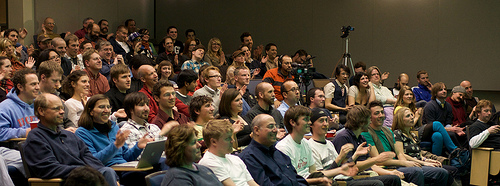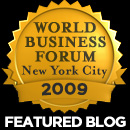Mar04
Andrea Meyer
Point: Business and communities can create a talent-attracting virtuous circle
Story: McKinsey & Co. partnered with the World Economic Forum to evaluate what makes a given region an “innovation hub.” McKinsey analyzed 700 variables and summarized the results in “Building an Innovation Nation.” Despite the report’s title, the principles apply to business and city regions as well.
The single common factor that drives innovation across all sectors is the availability of a well-qualified talent pool. Talent attracts talent, creating a reinforcing success cycle.
Let’s look at Boulder, Colorado to see these principles in action. Boulder is #1 in the nation for software engineers per capita. The tech community thrives largely due to the efforts of volunteers who organize regular meetings that let technologists find & talk with each other. Here are five examples. First, Rob Reich’s Boulder Denver New Tech monthly meet-ups are among the largest, attracting upwards of 350 technologists and entrepreneurs. The meetings feature presentations by new and emerging tech companies, who describe their business models and demo their software/products. Brian Tsuchiya’s Startup Entrepreneurs is another monthly meet-up, giving very early-stage entrepreneurs a chance to practice their pitch to a smaller audience and get feedback on their pitch & plan. Andrew Hyde’s Ignite Boulder events bring the community together in lighthearted events that are then livestreamed and archived. His Startup Weekend began in Boulder and is now in dozens of cities. Jeremy Tanner organizes unconferences like PodCamp Boulder. TechStars provides seed funding, office space to mingle and mentors from whom to learn. Local venture capitalists like The Foundry Group are active in sharing their insights through Boulder Open Coffees, presentations at Silicon Flatirons and mixers like StartUp Drinks. Local businesses like PR firm Metzger Associates are regular sponsors of many events. At all of these events, companies looking to hire and candidates looking for jobs can announce their presence.
Action: Help specialists in your community find each other through mixers and events. Create public calendars (such as Andrew Hyde’s Boulder.Me) to let everyone know about upcoming events. Share highlights of past events to give newcomers a flavor of them (see Rocky Radar and w3w3 Talk Radio). Participate in these events to find potential new hires and new business opportunities. Emphasize the resource-matching and idea cross-pollination opportunities of these events.

Ignite Boulder Feb 2009 by Stepan Mazurov
Entrepreneurs, How-to, Innovation, Opportunity
Mar02
Andrea Meyer
Point: Use a constraint to convert complexity into simplicity
Story: In 1954, Life magazine published an article on illiteracy among schoolchildren, reporting that children were not learning to read because their books were boring. “Pallid primers” featuring girls and boys who were “uniform, bland, idealized and terribly literal,” its author, John Hersey, contended. Publisher William Spaulding of Houghton Mifflin wanted to change that. He approached his friend Theodore Geisel (later known as Dr. Seuss) to write a much more lively primer. But he gave Geisel a challenge: the book could only use a vocabulary of 225 words, so that beginning readers could read it. Geisel took up the challenge. The result? The Cat in the Hat. Dr. Seuss used clever combinations of the 225 words and fanciful illustrations to create a playful story.
Action: A constraint limits the creative choices you have. Instead of viewing the constraint as merely negative and frustrating, consider the positive side: you can ignore those choices. Strip your problem to its basic elements. Then generate unusual combinations of those bare building blocks to look for a creative solution. This technique can be used in marketing, product development and strategy.
For more: Dr. Seuss & Mr. Geisel by Judith Morgan, Neil Morgan, Neil Bowen Morgan
Creativity, How-to, Innovation, New Product Development, Strategy
Mar01
Andrea Meyer
Point: Jump in and create, don’t worry about getting it right the first time
Story: My friend Joel wanted to write a novel. He took classes. He turned in assignments. But, he just inched along because he tried to perfect each piece. Then he heard about “National Novel Writing Month.” The goal: write a 175-page novel during the month of November. Sounds intimidating — 50,000 words — but it comes down to 1666 words a day.
My first reaction was, “but would the novel make sense?” Joel pointed out that the rationale was not to have a publisher-ready novel in a month. “The point is practice,” he said, “and to have much more material to work with than you’d have otherwise.”
To meet the fast pace of the challenge, Joel had to give up his inner critic and just crank out some writing every day. Now he’s got the draft of a novel. He’s got some gems, and he’s got material to refine.
This process applies to writing business plans, marketing collateral, sketching new product ideas and other daunting tasks.
Action: The first step is to set a goal with a deadline. Then commit to making some progress every day. Rolling up your sleeves and jumping into a task creates momentum. The result is something tangible that you can refine.
Creativity, How-to, Innovation, Productivity










